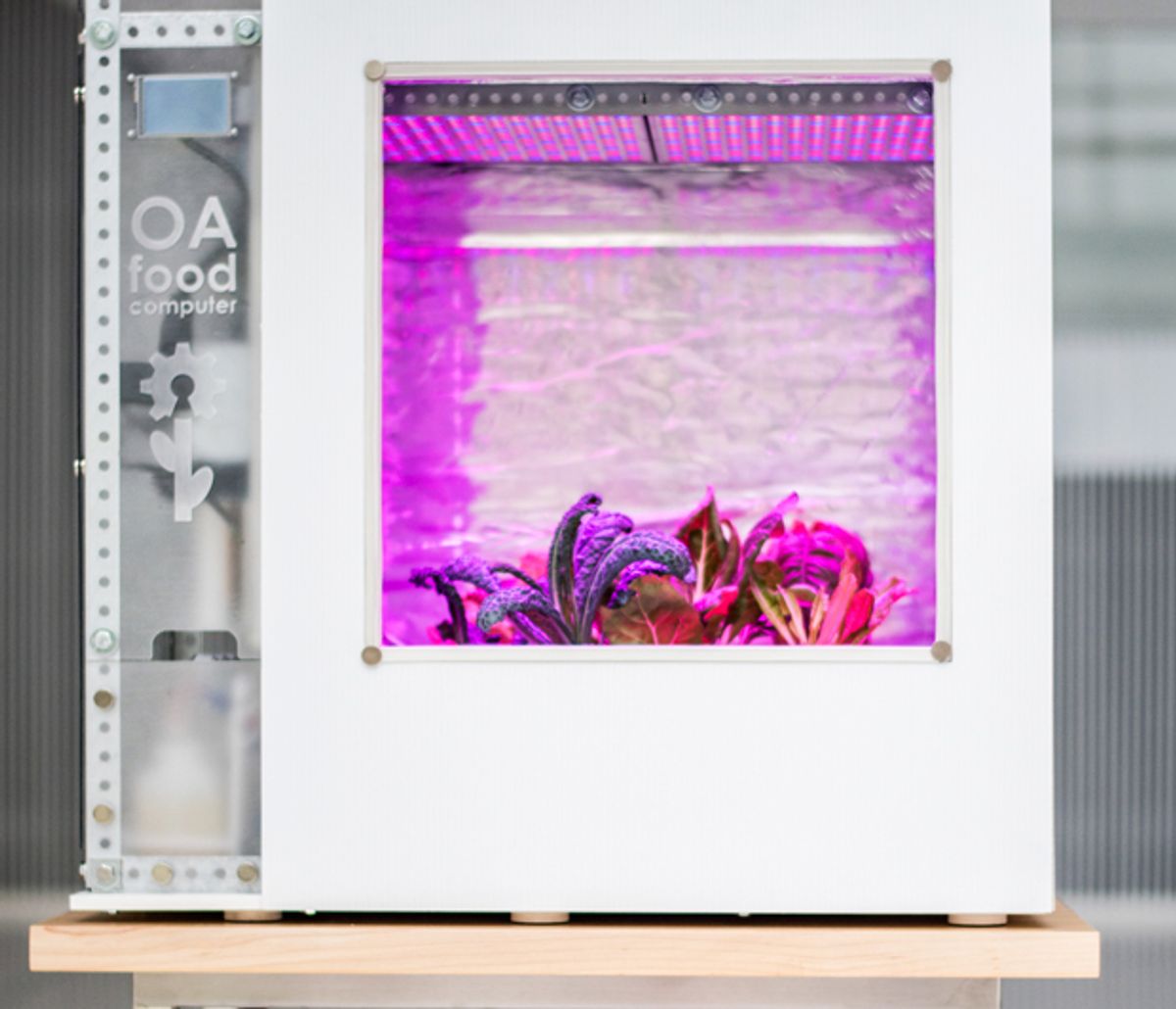Is urban agriculture on the verge of an Internet-enabled revolution? According to a team of technologists at MIT, this unexpected possibility may yet emerge from a series of recent technological breakthroughs. These include the development of high-efficiency blue LED lighting, whose inventors received the 2014 Nobel Prize in Physics.
The MIT researchers say that as technology enables new farming opportunities in indoor, warehouse-based settings, food production can be retooled to accommodate high-density urban living and maintain food security despite a future of increasing climate instabilities and vulnerabilities. The visionaries behind this new farming tech are working toward a networked agricultural system that looks to the open-source software movement for inspiration.
“The current state of [networked agriculture] is very one-off,” says Caleb Harper, principal research scientist for the Open Agriculture (OpenAG) Initiative at MIT’s Media Lab. “Everybody designs their own little unique ‘data center’ for plants, for a warehouse farm or for a vertical farm. They say it’s super special, and they try to create intellectual property out of it. And they won’t let people go in it, because they don’t want other people to steal their brilliant ideas. That’s the problem in my industry now. They haven’t realized that there’s a system that underlies this. And it won’t scale until there is a common platform.”
The common platform that Harper’s OpenAG Initiative is developing is an open-source, digitized food-growing system that his group calls the Food Computer, or FC. As one of Harper’s recent papers explains, the FC “creates a controlled environment using robotic control systems and actuated climate, energy, and plant sensing mechanisms. Not unlike climate-controlled data centers optimized for rows of servers, FCs are designed to optimize agricultural production by monitoring and actuating a desired climate inside of a growing chamber.”
Sensors inside an FC monitor the growing conditions for the crop and fine-tune the light exposure, temperature, humidity, carbon-dioxide level, water cycle, and nutrient exposure according to a preset recipe for growing the plant. (FC plants do not grow in soil but instead are either hydroponic, with nutrients injected into the water surrounding the roots or misted onto the plant’s dangling, open-air roots.) The recipes for each crop, as well as the controlling software and sensing data, will all be freely circulated among Food Computer users for tweaking and improvement—regardless of whether the FC is in a desert, the Antarctic, or on another planet.
Food Computers, as OpenAG conceives them, come in three sizes, with names that reveal Harper’s data-center design background. On a recent visit to the Media Lab’s fifth-floor OpenAG development space, Camille Richman, a mechanical engineer with the OpenAG Initiative, points out both a tabletop prototype called the Personal Food Computer and a plexiglass-walled walk-in growing module the size of a shipping container, filled with lights, pipes, and racks of plants. “That’s the Food Server,” she says. “And the warehouse-scale unit, which is the biggest we’re looking at, we’re calling the Food Data Center.” The idea behind making FCs in three sizes is to standardize agricultural tech platforms for personal, small-scale, and large-scale use. What’s more, growing conditions suitable to a particular crop that are developed inside a tabletop-size Food Computer can then be scaled up to the shipping-container-size Food Server or even the Food Data Center, which may occupy part of a warehouse, factory, or other large building.
To date, there are fewer than 10 Food Computers worldwide: six Personal Food Computers at MIT and Boston-area public schools, plus two Food Servers—one at MIT and one at Cinvestav (the Center for Research and Advanced Studies of the National Polytechnic Institute) Unidad Guadalajara, in Mexico. The first Food Data Center is scheduled to be built near MIT later this year.
But those numbers will undoubtedly be growing, says Dickson Despommier, emeritus professor of microbiology and public health at Columbia University, in New York City. The computerized vertical farming industry has been booming in recent years and will only get bigger. The expected explosion will come, he says, largely as a result of the phenomenal increase in efficiency that the latest generation of LED grow lights has introduced—from 28 percent efficiency five years ago to 68 percent today. Because grow lights’ power usage represents the largest chunk of an indoor farm’s operating expenses, Despommier says, the cost savings that the newest lights yield are enough to make vertical farming increasingly economically viable.
Japan, he says, has 145 vertical farms; Taiwan has 45. China just announced an order for 20. And the United States has more than a dozen scattered across California, Delaware, New Jersey, Texas, and Wyoming—and now, of course, in Cambridge, Mass. (Though, to be clear, only Cambridge has any of OpenAG’s Food Computer–related hardware or software.)
The time it takes to see a full return on investment “has gone down from 10 or 12 years to between 6 and 8—and in some cases, even 5 years,” Despommier says. “The other thing that’s been remarkable is, I don’t know of any [vertical farming] company in the United States that isn’t in expansion mode. That tells you everything.”
Margo Anderson is senior associate editor and telecommunications editor at IEEE Spectrum. She has a bachelor’s degree in physics and a master’s degree in astrophysics.



